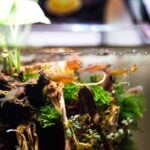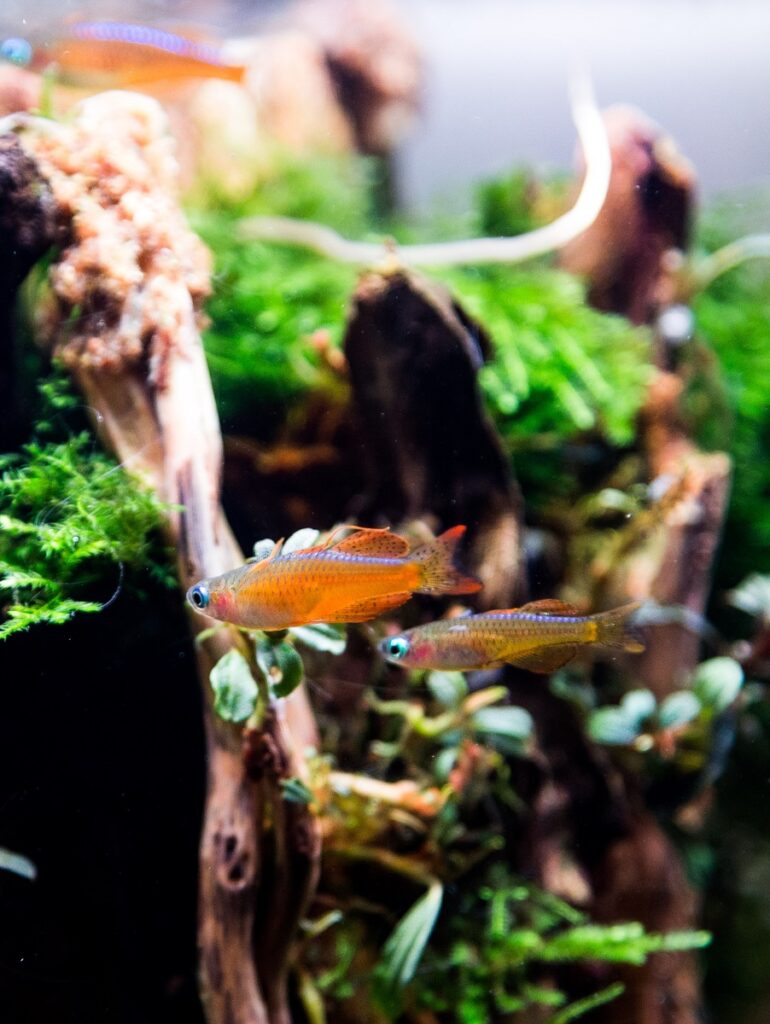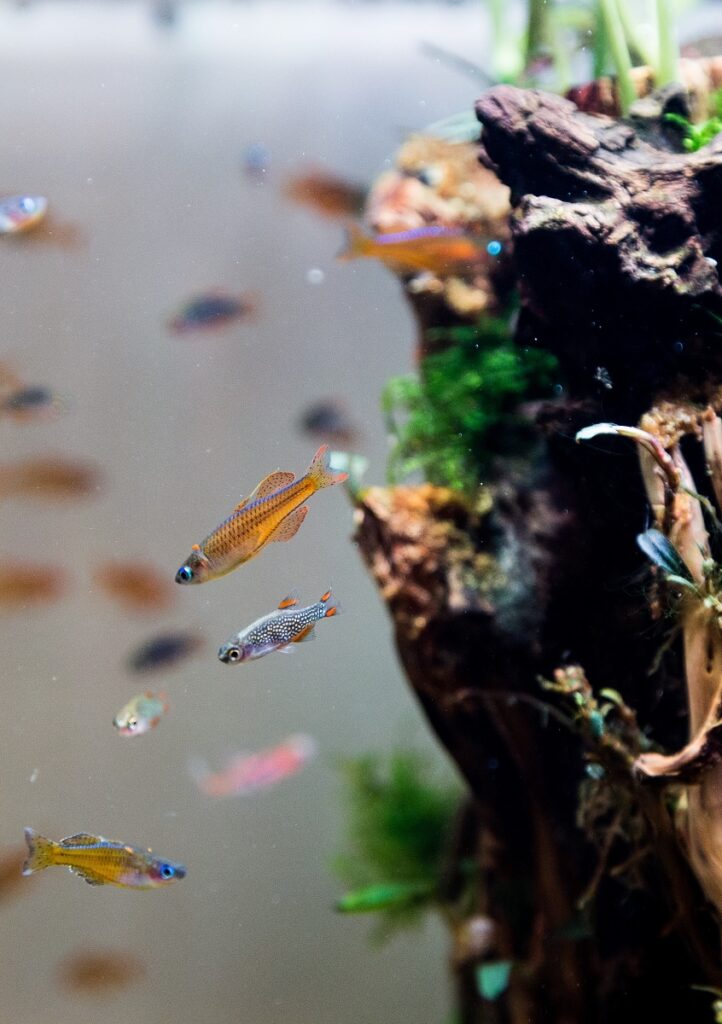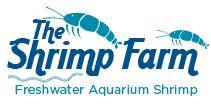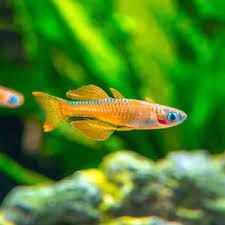Red Neon Blue-Eye Rainbowfish | Care & Info
Is your peaceful community aquarium in need of a pop of color, or are you looking for an interesting fish species to build a tank around? Dwarf rainbowfish might be just the thing for you. One of our favorites is Pseudomugil luminatus, a colorful species also known as the red neon blue-eye rainbowfish.
Below, you'll find everything you need to know about these small rainbowfish, including where they're from, how to care for them, and how to breed them in the home aquarium.
| Scientific name | Pseudomugil luminatus |
| Common names | Red neon blue-eye rainbowfish |
| Difficulty level | Easy |
| Origin | Papua, Indonesia |
Table of Contents
Red neon blue-eye rainbowfish appearance & natural habitat
Appearance
Its common name may be quite a mouthful, but it does describe this fish perfectly! All fishes of the genus Pseudomugil are nice to look at—the forktail blue-eye rainbowfish is another great example—but we think this shimmering number is particularly stunning.
The males of this species are the lookers, sporting neon red to orange body and fin coloration with subtle darker dotting. An iridescent blue line runs from the dorsal fin to the tail, and the eyes are an intense blue in color as well. The pectoral fins are upturned, giving these fish a sort of permanent "cheering" look.
Female rainbowfish are less colorful, but still nice to look at. Their bodies are greyish to yellow, with yellow fins. They also have a blue body line and blue eyes, although the color is less intense.
Did you know? Although this rainbowfish has been present in the aquarium hobby since at least 2011, often named Pseudomugil 'Red Neon' for lack of a proper name, it wasn't scientifically described until later. Basically, researchers received the first specimen in 1997, but thought it was an unusual Pseudomugil paskai rainbowfish.
The whole thing was finally resolved when legendary ichtyologist G.R. Allen and two other authors published a study in 2016, which marked the red neon as a separate species: Pseudomugil luminatus.
Natural habitat
The red neon blue-eye rainbowfish is naturally found exclusively in a small part of the island of New Guinea, specifically in the Timika region of the Indonesian Papua province. It inhabits palm swamps and forest streams, often stained dark by tannins.
Unfortunately, the IUCN Red List considers this species to be Endangered. It has disappeared from its type locality (the location where the specimen used to first scientifically describe the species was found) as a result of habitat destruction for mining operations. Oil palm plantations and the rapidly expanding human population in the region are also problematic for the red neon blue-eye.
Field studies have recorded larger scale development activities including logging, mining, plantations, roads, and development of new government centers, which all have a direct impact on rainbowfish habitat.
Freshwater fish diversity in an oil palm concession area in Mimika, Papua by H. Ohee, 2016
Setting up a red neon blue-eye rainbowfish aquarium
Requirements
Although they're small, Pseudomugil rainbowfish are active little swimmers that should be kept in groups. This means they're not suitable for nano aquariums; it's better to go for a 15-20 gallon tank.
When setting up an aquarium for a school of red neon blue-eye rainbowfish, it helps to keep this species' natural habitat in mind. They thrive in swamps and forest streams—the kind of environment where not much light penetrates, especially since the water can be murky. Leaf litter and aquatic vegetation abound.
As such, your rainbows won't appreciate being stuck in a stark and light tank. Try keeping things relatively dim if you want to see your fish colored up and out in the open: dark substrate, dark background, possibly floating plants, and plenty of décor like live plants, rocks, and driftwood. You can sprinkle some leaf litter around the bottom as well.
Water parameters
Red neon blue-eye rainbowfish are not picky when it comes to water composition but don't tend to respond well to low water quality. It's best to introduce them in a mature aquarium; the tank should always be fully cycled before adding livestock of any kind. Don't forget to do weekly water changes and perform regular tank maintenance.
If the space you're planning on keeping your rainbowfish in is at a stable room temp (no more than a few degrees difference between day and night), you may be able to get away with keeping them in an unheated aquarium. Do make sure their tankmates can handle lower temperatures as well.
pH: 6-7.5
Temperature: 65-82 °F
Hardness: 50-200
Tankmates
If you'd like to keep red neon blue-eye rainbowfish, it's important to keep in mind that in order for them to really shine, you should get a group of at least 6-10 fish. This ensures multiple males and females, meaning you'll get to see the males compete and show off their nicest colors for the ladies.
Some aquarists, especially those interested in breeding these rainbowfish, keep them with their own kind only. However, they can do well in a community aquarium. You just have to go for similarly small tankmates that won't bother them and that thrive in similar water values.
You could consider:
- Rasboras, such as the kubotai rasbora
- Danios, such as the celestial pearl danio
- Bottom dwellers like kuhli loaches or panda Cories
- Peaceful catfish like Otocinclus
- Amano shrimp
- Snails, such as nerites
For the dwarf shrimp enthusiasts: yes, aquarists have reported success combining these rainbowfish with their shrimp. Apparently, their mouths are so small they struggle to catch even baby shrimp. While we wouldn't keep them with expensive shrimp, fast breeders like Neocaridina should do fine, especially in a densely planted set-up.
Red neon blue-eye rainbowfish diet
These little fish are predators that require a varied diet to thrive. Live foods like Daphnia or brine shrimp are ideal, especially if you're trying to breed them. If that's not an option, you can try different frozen foods. They'll also take micropellets and very small flakes.
If you keep your red neon blue-eye rainbowfish in a community aquarium, keep an eye on them to ensure they're actually eating. Larger fish, like tetras, are bolder and may outcompete the rainbows for food.
Breeding red neon blue-eye rainbowfish
As mentioned, this species is endangered in the wild. Luckily, they breed readily in the aquarium, so most of the fish available are now bred in captivity. If you keep a sizeable group, they'll spawn pretty much year-round, scattering their eggs in fine-leaved plants and then leaving them to fend for themselves.
In densely planted aquariums, some of the fry may make it to adulthood, but it's likely most of the eggs and baby fish will be eaten by their tankmates (or even their parents!). If you want a better survival rate, you're best off raising the fry separately.
Here's how you do it:
- If your rainbows aren't spawning yet, you can slightly raise the temperature and feed plenty of nutritious live foods to get them in the mood.
- Place spawning mops or Java moss in the tank for the fish to deposit their eggs in.
- Once eggs have appeared, move them to a separate container filled with water from the main tank, an air stone, and maybe some floating plants. Perform daily small water changes.
- The eggs will hatch after around two weeks. The tiny fry feed on their yolk sacs for the first few days, but should be fed tiny powdered foods, baby brine shrimp and similar once they're free-swimming.
- When the fry are large enough to avoid being eaten, they can be moved to the main tank. This can take a while, as they're known for being slow growers.
Buying red neon blue-eye rainbowfish
Because they're a relatively new addition to the aquarium hobby, red neon blue-eyes can be a little more difficult to find than some of their cousins in the Pseudomugil genus. Still, aquarists have definitely caught on, and you can usually ask your local fish store to order some in for you if they don't have them in stock.
You can also order your fish online. The Shrimp Farm sells tank-bred red neon blue-eye rainbowfish and ships them right to your doorstep with live arrival guarantee!
Allen, G. R., Unmack, P. J., & Hadiaty, R. K. (2016). Pseudomugil luminatus, a new species of Blue-eye (Teleostei: Pseudomugilidae) from southern New Guinea, with notes on P. gertrudae. Fishes of Sahul. Journal of the Australia New Guinea Fisheries Association, 30(1), 950-961.



 Shrimp
Shrimp Fish
Fish Crab &
Crab & Plants
Plants Foods
Foods Snails
Snails